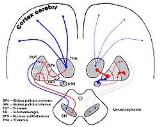
Parkinson's disease
Overview
Parkinson's disease is a degenerative
disorder of the central nervous system
. The motor symptoms of Parkinson's disease result from the death of dopamine
-generating cells in the substantia nigra
, a region of the midbrain; the cause of cell-death is unknown. Early in the course of the disease, the most obvious symptoms are movement-related
, including shaking
, rigidity
, slowness of movement and difficulty with walking and gait
. Later, cognitive
and behavioural problems may arise, with dementia
commonly occurring in the advanced stages of the disease.
Neurodegeneration
Neurodegeneration is the umbrella term for the progressive loss of structure or function of neurons, including death of neurons. Many neurodegenerative diseases including Parkinson’s, Alzheimer’s, and Huntington’s occur as a result of neurodegenerative processes. As research progresses, many...
disorder of the central nervous system
Central nervous system
The central nervous system is the part of the nervous system that integrates the information that it receives from, and coordinates the activity of, all parts of the bodies of bilaterian animals—that is, all multicellular animals except sponges and radially symmetric animals such as jellyfish...
. The motor symptoms of Parkinson's disease result from the death of dopamine
Dopamine
Dopamine is a catecholamine neurotransmitter present in a wide variety of animals, including both vertebrates and invertebrates. In the brain, this substituted phenethylamine functions as a neurotransmitter, activating the five known types of dopamine receptors—D1, D2, D3, D4, and D5—and their...
-generating cells in the substantia nigra
Substantia nigra
The substantia nigra is a brain structure located in the mesencephalon that plays an important role in reward, addiction, and movement. Substantia nigra is Latin for "black substance", as parts of the substantia nigra appear darker than neighboring areas due to high levels of melanin in...
, a region of the midbrain; the cause of cell-death is unknown. Early in the course of the disease, the most obvious symptoms are movement-related
Motor skill
A motor skill is a learned sequence of movements that combine to produce a smooth, efficient action in order to master a particular task. The development of motor skill occurs in the motor cortex, the region of the cerebral cortex that controls voluntary muscle groups.- Development of motor skills...
, including shaking
Tremor
A tremor is an involuntary, somewhat rhythmic, muscle contraction and relaxation involving to-and-fro movements of one or more body parts. It is the most common of all involuntary movements and can affect the hands, arms, eyes, face, head, vocal folds, trunk, and legs. Most tremors occur in the...
, rigidity
Spasticity
Spasticity is a feature of altered skeletal muscle performance in muscle tone involving hypertonia, which is also referred to as an unusual "tightness" of muscles...
, slowness of movement and difficulty with walking and gait
Gait
Gait is the pattern of movement of the limbs of animals, including humans, during locomotion over a solid substrate. Most animals use a variety of gaits, selecting gait based on speed, terrain, the need to maneuver, and energetic efficiency...
. Later, cognitive
Cognition
In science, cognition refers to mental processes. These processes include attention, remembering, producing and understanding language, solving problems, and making decisions. Cognition is studied in various disciplines such as psychology, philosophy, linguistics, and computer science...
and behavioural problems may arise, with dementia
Dementia
Dementia is a serious loss of cognitive ability in a previously unimpaired person, beyond what might be expected from normal aging...
commonly occurring in the advanced stages of the disease.
Unanswered Questions
Discussions

